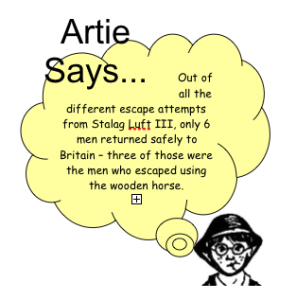A Short History of Escape
 Where there are people held against their will, there will also be those who will escape. And where there is escape, there is always a ‘helper’.
Where there are people held against their will, there will also be those who will escape. And where there is escape, there is always a ‘helper’.
‘Escape’ is something that has been happening for centuries; from the mass break-out of gladiators at Capua (Ancient Rome) in 73 BC, to the fugitive King Charles II, disguised as a woodsman and lying hidden amongst the branches of a tree following the execution of his father King Charles I (1651). And then on to the Underground Railroad of 1812 – 65 in the United States, which helped black slaves escape to the free North.
For WW2 Prisoners of War, escape was considered to be their duty; it caused enemy troops to be taken away from the front line and occupied them in search parties. British POWs made numerous escape attempts, many were successful and all were quite ingenious. In Stalag Luft III alone over 100 different tunnels were started.
Here are just some of history’s great escapes…
King Charles II – 1651.
Following the execution of his father a young Charles II came to claim his throne. But after finding his army defeated by Cromwell, Charles II was forced to flee and save himself. Disguised as a woodsman, he hid in an Oak tree, and although Cromwell’s army passed by him, they never looked upwards into the branches! Now on the run, and trying to make his way to France, Charles II relied on friends and ‘helpers’ to hide him. One of those helpers was Mary Lane, a sympathizer, who risked her life to help the King escape. Charles II arrived safely in France in October 1651.
The Underground Railroad – 1812-65.
This secret organisation in the United States helped runaway slaves escape to the north of the country. There were no trains involved. The organisation took its name from the routes that were referred to as ‘lines’; the slaves were known as ‘freight’; their guides as ‘conductors’ and the safe-houses were ‘stations’. Travelling took place at night using the stars to navigate, and the escapees followed riverside tracks and valleys. Some escapers later returned to the lines as guides, and by the time slavery was abolished the line had led over 40,000 slaves to freedom.
The Boer War, Churchill’s Escape – 1899
When Winston Churchill was captured whilst working as a war correspondent during the Boer War, he seized his opportunity to escape from his captors by scaling the prison wall. Initially guided by the stars, he made his way to a railway track, following it until he was able to jump onto a train that was travelling slowly after leaving a station. At dawn the following day, Churchill jumped from the train and headed towards a nearby settlement, knowing there were only a few British settlers in the area. After initially being spoken to in Dutch, Churchill was relieved to discover that he had reached the only British mining settlement for 20 miles. He was kept hidden there in a pit shaft, before being returned to British lines.
The Wooden Horse – 1943
During WW2 the POWs of Stalag Luft III were seen exercising using a wooden vaulting horse. Unbeknown to their German captors the horse, made of old Red- Cross packages, was actually a cunning escape plan. Each day the horse would be carried into the same position in the compound with two men hidden inside. Once the horse was in place the men would work at digging the soil below to form a tunnel. With the Germans using seismographs to detect tunnelling, the vault was also useful because the vibrations of the other men vaulting over it muffled the tremors caused by the digging.
By 29 October 1943, the tunnel under the wire was completed. Three men were to escape, Eric Williams, Michael Codner and Oliver Philpot, but they would need a fourth to replace the trap and the top-soil. At 6pm on the evening of the escape, the remaining prisoners created a diversion; this was the cue for escape. Breaking through the surface, they quickly ran for the cover of the trees. Once free, Williams and Codner travelled together while Philpot travelled alone. All 3 returned safely to Britain.

